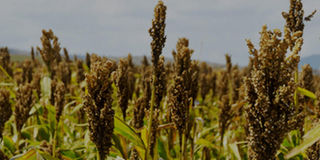Tanzanian brewer in partnership with WWF to restore Dar es Salaam watersheds
Sponsored by Tanzania Breweries Ltd

By Millicent Mwololo
Climate change is one of the most pressing global challenges of the moment. And beer brewing is closely tied to the natural environment, agricultural products and water being the key ingredients.
It is therefore no surprise that Belgian multinational brewing company, Anheuser-Busch InBev (AB InBev) – the parent company of Tanzania Breweries Limited – has invested in a two-pronged water management project that focuses on water use efficiencies inside the brewery and watershed protection on the outside.
AB InBev and the World Wide Fund for Nature (WWF) have partnered in implementing the Dar es Salaam Water Security Project, which seeks to restore the city’s watersheds through bankable nature-based initiatives.
The Dar es Salaam Water Security Project is an integrated water resources management, with particular emphasis on catchment conservation.
The project will contribute to the achievement of the Tanzania’s Development Vision 2025 and Africa’s water vision for 2025, which is about attaining, “an Africa where there is an equitable and sustainable use and management of water resources for poverty alleviation, socio-economic development, regional cooperation, and the environment.”
AB InBev and the WWF have previously partnered in different ways on water issues, for more than a decade. In Tanzania, TBL has highlighted its interest to invest in the watershed of Dar es Salaam, particularly in Msimbazi River. TBL has significant challenges with water supply, as water provided by the Dar es Salaam Water and Sewerage Authority (DAWASA) from Ruvu River is not enough, while water from some of the boreholes is low in capacity and quality.
Generally, TBL receives approximately 70 percent of the total water required by the industry. The company recycles and treats wastewater before using it for washing and thereafter discharging to Msimbazi River.
The Dar es Salaam Water Security Project covers upper Ruvu, lower Ruvu, Kinyasungwe, Wami, Mkondoa, Ngerenge, and the Coast.
The Dar es Salaam watersheds include the coastal and lower catchment of Wami-Ruvu basin. The Lower Ruvu and coast catchments extend from Morogoro to the west of Dar es Salaam, covering an area of about 18,000 square kilometres.
The entire Dar es Salaam watershed ecosystem faces various threats. For instance, Ruvu River, which supplies water to Dar es Salaam city, is facing water availability challenges. The river has been affected by unsustainable agriculture and poor land use practices, livestock incursion, and unregulated water abstractions. Ruvu River is heavily polluted through mining and agricultural activities, and has been affected by deforestation and general catchment degradation.
The river is also under the threat of climate change, and monitoring systems for what has been happening on its waters over the years are inadequate.
On the other hand, both Msimbazi and Mzinga rivers are under the threat of sand mining, flooding, and high pollution, due to wastewater and solid waste disposal, and the subsequent blockage of water flows. Valley cultivation, lack of vegetation along the riverbanks, sedimentation, and infrastructure barriers, add to the challenges.
Also, groundwater abstraction in Dar es Salaam is not well managed. There are many unlicensed boreholes, putting water supply at risk.
AB InBev has flagged Dar es Salaam as one of the ‘high risk’ sites in Africa in terms of water supply. Dar es Salaam features a high demand for water against poor water infrastructure.
The water security project in the city is focused on capacity building, good governance, and finance, to address the quality and quantity of water, which is on an upward trajectory towards the 2025 goal.
The project seeks to establish the quality and quantity of water in key rivers of the Dar es Salaam watershed, and engage both private and public stakeholders to explore bankable nature-based solutions by the end of 2022. It also purposes to select, manage, and finance scalable watershed management and restoration initiatives to improve water quality and quantity by the end of 2022.
Bankable nature-based solutions
Another key objective is to develop a large-scale bankable nature-based solutions business case to leverage on funding from private, public and development partnerships, for improved water quality and quantity, and restoration of ecosystems, by 2024. A bankable project is one that in many cases uses blended finance, has a positive environmental impact, and generates a positive return for certain stakeholders.
The funding required is $600,000 to implement the project in a span of three years. In their strategy for a sustainable nature-based solution, the bigger water users – Coca Cola and TBL – have put together interest-free funds for grants and loans to environmental conservation groups and investors in environmental conservation. This is expected to improve the water quality and quantity in the Ruvu, Msimbazi and Mzinga Rivers.
The commitment that AB InBev has shown in this project further reinforces the fact that your favourite TBL brands have embraced sustainability to build a resilient environment for everyone to live in. Improving water availability in high stress areas in Dar es Salaam is one way of ensuring that there is a resilient natural environment, and healthy and strong communities of farmers and beer lovers.
Already, TBL and WWF have fabricated and installed concrete beacons in degraded water sources in the coast and lower Ruvu catchment. Re-vegetation through tree planting on about 200 hectares of land in the coast region and lower Ruvu catchment has been undertaken. Also, five cattle troughs have been constructed in lower Ruvu and eight environmental groups have been formed in the lower Ruvu catchment.
A mapping exercise has also identified the major water users from lower Ruvu and coastal catchments. Already, 15 private sector players have been promoted to create their own bankable projects. Two charcoal dams have also been constructed for water catchment and retention.
Click here for an infographic breakdown of the Dar es Salaam Water Security Project.


